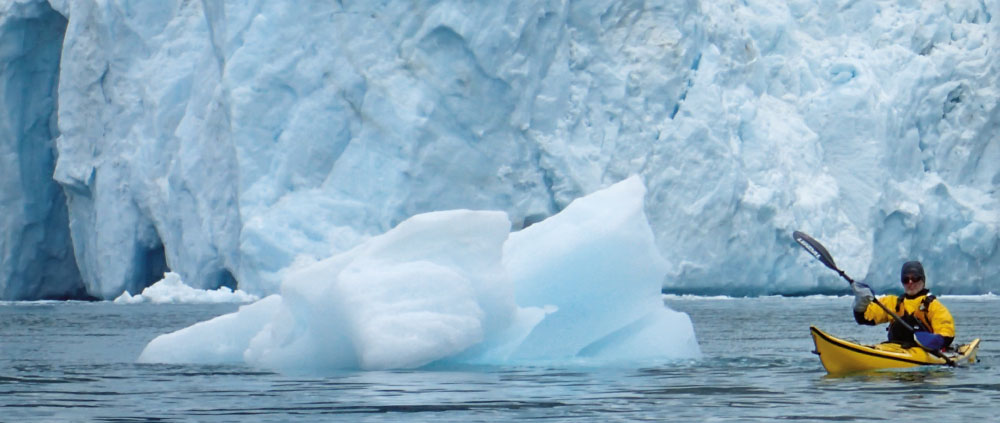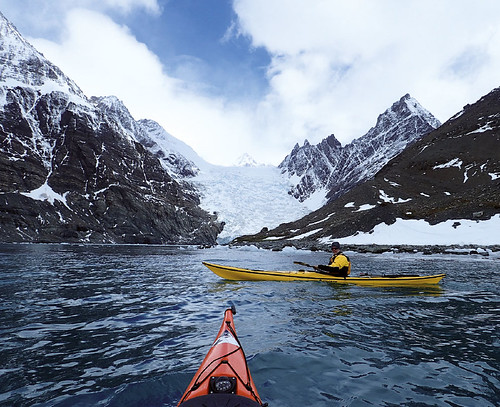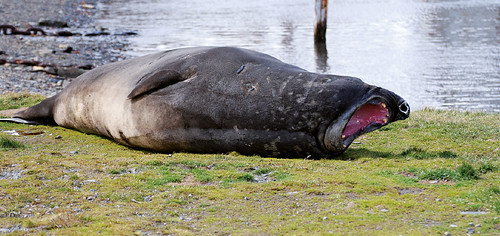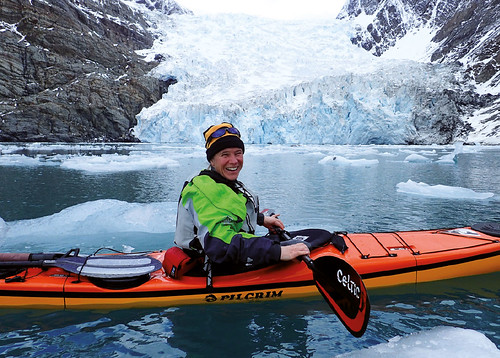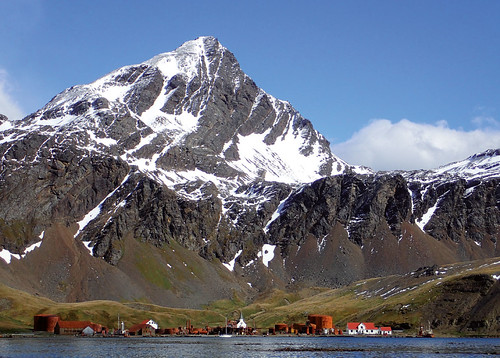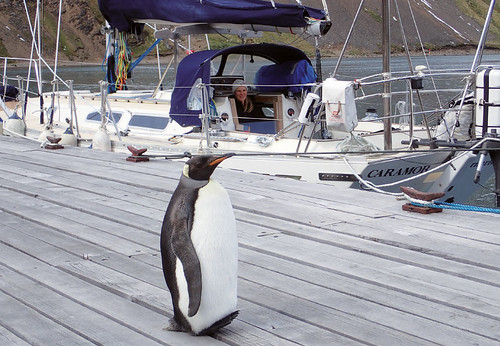Article: Kath McNulty
It is 3:30am, Franco’s watch should have ended an hour and a half ago. We have just finished hauling the drogue back in, heavy work. We deployed it during the hours of darkness, to slow Caramor down, hoping to drift at the same speed as the icebergs, they are all around us, invisible in the thick fog. He sits on the bench, hardly able to keep his eyes open, I’m not sure he even knows his name anymore.
By mid morning, the wind has increased to Force 8 on the Beaufort scale. It is howling out there. The sea is wild and foamy. South Georgia is nearby and we are keen to make landfall as the forecast is for even stronger winds tomorrow. We are heading for Rosita Harbour on the north-east coast where we hope to find an all weather anchorage.
A sheer cliff looms out of the fog, Cape Buller at last. We reduce the genoa even further, turn on the engine, drop the main and, with the engine ticking over, sail into Rosita Harbour on a tiny piece of genoa. The sea flattens as soon as we are in the lee of the cape but the wind accelerates as it falls off the 200m cliffs. Spray is flying everywhere and the williwaws knock Caramor sideways from the left, then from the right, a 180˚ switch in wind direction! With gritted teeth, we hunker down.
A cove opens out on our right, no shelter there, the water boils, tormented. We continue past the next point and beyond the kelp, there is a bay with calm water. We have come to the end of the world, or at least to the end of the human world. The animals all seem to think it is a lovely day and the fur seals are having, quite literally, a ‘wail’ of a time.
It all started one Tuesday lunchtime, many years ago, in my Welsh class. We watched a documentary in which the famous Welsh TV presenter Iolo Williams visits ‘De Georgia’ by yacht. He was filmed just a few feet away from penguins against an amazing backdrop of glaciers and snowy peaks.
I had never heard of ‘De Georgia’ or even ‘South Georgia’ (in English) for that matter, and had no idea where it was. I knew there were no penguins in Georgia, USA nor in Georgia, Russia, and that penguins don’t visit the north pole. I simply had to find out more.
South Georgia is in the Southern Ocean, an island a little smaller than Wales. The Falkland Islands, 1,450km north-west, is the nearest inhabited land.
It has been administered by Britain since 1908, except for a brief period in 1982 when occupied by Argentina. After the Falklands War, it became independent of the Falkland Islands and is now the UK Overseas Territory of South Georgia and the South Sandwich Islands. Although the same distance from the equator as Lancashire, it lies within the Antarctic Front (previously known as the Antarctic Convergence Zone). The weather is unpredictable and changeable, mostly it is cold, windy with frequent fog. The terrain is mountainous, with most of the land above a thousand metres and the tallest peak, Mount Paget, at 2,943m. Although alpine in height, the conditions are Himalayan, with sixty percent of the land permanently covered with snow and ice. The south-west coast is desolate and constantly pounded by strong winds and seas straight off the Antarctic continent. The north-east coast has a few large bays where ships may find refuge in a gale but the approaches are littered with icebergs and the waters poorly surveyed.
At the time I had recently taken up sea kayaking in earnest, and decided that it would be fun to kayak around South Georgia. Then I read ‘South’, Shackleton’s account of his 1914 aborted expedition to cross Antarctica. After the Endurance had been crushed by the ice, the men took to the ice floes and survived on seal and penguin meat until they drifted into open water. They then launched their small open boats and made it to Elephant Island off the Antarctic Peninsula. With no prospect of rescue, Shackleton and a few other men set sail across the Southern Ocean towards South Georgia where they knew they would find people. Meanwhile the remainder of the party stayed on Elephant Island living under the upturned boats. The crossing, an amazing feat of navigation, was horrific but they eventually succeeded in landing on the exposed south-western coast of South Georgia. Shackleton, Worsley and Crean set off on foot and crossed over the mountains to the Stromness whaling station. It was many more months before they were able to rescue the Elephant Island party. ‘South’ is an epic tale of survival and records the first small boat journey along the southern coast of South Georgia!
Kayaking in South Georgia sounded a little more serious than a paddle in Cardigan Bay, maybe I needed to think again. I was curious though, had anyone ever circumnavigated the island by kayak?
The first sea kayaking attempt on South Georgia was in 1991. The Royal Anglian South Georgia Expedition set off to circumnavigate in a clockwise direction. It was a very cold year and the four British servicemen got no further than the south-east corner where they became storm bound for weeks and resorted to eating penguins to supplement their dwindling food supplies. The Royal Air Force attempted a food drop by parachute but just as the parcel was about to land a strong gust of wind whisked it away and it disappeared into the ocean. A month and a half after setting out from Grytviken, they were rescued by a military support vessel from the Falklands.
The second attempt was five years later by an Australian/North American three man team. They headed anti-clockwise and got all the way up the north-east side and a third of the way down the south coast at which point they called it a day and hauled their kayaks over the spine of the island back down to the other side – a valiant effort!
By 2004 South Georgia’s reputation had grown among sea kayakers and several experienced paddlers had set their ambitions on rounding her shores. The price was high, she wasn’t going to play easy. By southern hemisphere spring 2005, two teams were ready and had booked support yachts. The New Zealand ‘Adventure Philosophy’ team of Graham Charles, Mark Jones and Marcus Waters arrived first in charter yacht Northanger. They set off on 13 October and took 19 days to complete the circle. Just three months behind them was a British team.
I was training hard and, after a bit of an epic in the tide race at Penrhyn Mawr, Anglesey, signed up for a five star training course with Nigel Dennis (Sea Kayaking UK). Nigel had been a member of that British team. Together with Peter Bray, Geoff Allen and Hadas Felman (from Israel), they had circumnavigated South Georgia in just 14 days, five days faster than the Kiwis! To succeed they had battled with the aggressive fur seals guarding the beaches and the strong winds, sometimes up to 45 knots.
So it was possible … but getting to South Georgia wasn’t easy. Unlike Antarctica, you can’t fly there, and there is no public transport. The only options are by government or British Antarctic Survey (BAS) ship, by cruise liner, or by private or charter yacht. What is more, you have to complete a lengthy application process to demonstrate your ability to survive your proposed expedition and you must have a support vessel in attendance at all times, an expensive logistical nightmare. It was looking like South Georgia was out of my league. Other than the lack of penguins, Anglesey is a fabulous kayaking destination, I had no need to travel all that way.
I forgot about South Georgia until one night in the pub in Llanberis when I mentioned it to Franco Ferrero who owned a sailing yacht. We made a deal; sail to South Georgia and then continue around the world. Our aim was to get there and back, safely, by our own means. We knew there was nowhere secure to leave the yacht unattended for an extended period so if we did go kayaking, it would be for just a few hours at a time in settled weather.
For the next four years we worked on our plan. Franco bought a larger 36’ sailing yacht, Caramor, which we adapted for our journey. I finished building my house, packed in my job and Franco moved his book publishing business ‘Pesda Press’ onto the boat. We were ready.
In the meantime I read about two further kayaking expeditions to South Georgia. In 2010, a Norwegian team of three men and one woman completed a twenty day circumnavigation. Half way around, an elephant seal had rolled over in the night and crushed one of their kayaks. Luckily they had enough supplies of fibreglass and resin to repair it and carry on. A year later Hayley Shephard from the U.S.A. attempted a solo circumnavigation. She was raising funds to protect the wandering albatross, endangered by poor practices in the long line fishing industry. Unfortunately she suffered a few setbacks. Her charter yacht set sail from Ushuaia but a couple of days into the journey, the co-skipper lost a finger while working on the engine. They diverted to the Falklands to seek medical care. A new member of crew was recruited but they still arrived several weeks later than planned in South Georgia. There was more bad news, Hayley’s kayak, sent ahead by cruise ship had been badly damaged and it took a few days to repair it. The Antarctic summer is short and time was running out, she was forced to give up at the northeast tip of the island.
I am aware of one other kayak expedition which remains undocumented; Leif Poncet from the Falkland Islands is reputed to have kayaked solo around South Georgia purportedly as part of an all-island petrel and historic sites survey. Leif is no stranger to these waters, he spent much of his childhood sailing with his parents Jerôme and Sally, both pioneers of Antarctic cruising.
In November 2015 we arrived at Port Stanley, Falkland Islands. Then, two months later, in early January, at the height of the southern hemisphere summer, we sailed 851 nautical miles across the Southern Ocean to the northern tip of South Georgia. If you accept King penguin rookery St Andrews Bay that in those latitudes F6 is a pleasant breeze, then we enjoyed an idyllic crossing. Our arrival was less so, F8 with gusts of 60 knots batting us around like a pingpong ball, a snow blizzard raging and practically zero visibility.
Today South Georgia is a wildlife haven with large numbers of birds and seals spending the summer there to mate, give birth and moult, but it wasn’t always thus. Sealing began in the late 1700s and by the early 1800s fur seals had practically been wiped out. Between 1904 and 1960, tens of thousands of whales were killed for their blubber. Fur seal populations have recovered but it is still rare to see a whale.
In the heyday of the whaling industry over a thousand people lived and worked on the island. They have all gone and there are no longer any permanent human inhabitants, though there is a small transient population of government employees and BAS scientists. In Grytviken we were met by the Minister for Penguin Affairs and Simon, a friendly government officer who briefed us about the dos and don’ts and explained that the rats (originally introduced by had whalers) had recently been eradicated at great expense.
We sailed the yacht around to Cobblers Cove, a beautiful enclosed natural harbour with a macaroni penguin rookery nearby. These amazing little birds became our firm favourites, always active, stealing pebbles from each other, chaperoning the chicks, displaying, and working as a team to chase away potential predators. In Ocean Harbour the fur seals prevented us from going for a walk. Behind the narrow beach, the steep bank covered in tussock grass is a death trap for unsuspecting humans as the fur seals lie in ambush, honing their sharp teeth. Fur seals are eared seals and very different to the common and grey seals in the UK, on shore they can gallop faster than a person can run and are extremely territorial and aggressive, even with each other. Their bite may sever an artery or expose bone and the wound always becomes infected. They tolerated us on the beach where we spent a happy afternoon watching the pups learning to swim (yes, even seals have to learn). They flapped around in circles splashing frantically and then suddenly, as if responding to the swim master’s whistle, piled out of the water and waited by the side of the pool, staring at us. We travelled on to St Andrews Bay where we wandered among 300,000 king penguins, nearly half of which were incubating eggs on their feet with their downy bellies tucked over for warmth. The adults’ call sounds like a trumpet whereas the chicks in their brown downy coats whistle for attention. A young penguin took a fancy to us and spent an hour watching us quizzically, standing less than a metre away. I admired the seamless way they landed through the dumping surf, if only I could pull it off that elegantly in a kayak. A teenager with a fluffy head attempted to launch, the result was an unmitigated disaster and after dusting himself down he scurried back up the beach to safety.

A couple of days later we were back in Grytviken for Franco’s sixtieth birthday. It was sunny and the light wind had gone northerly, perfect conditions for kayaking up Moraine Fjord to the snout of the Hamberg and Harker glaciers. We assembled our three piece Pilgrim kayaks on the jetty at the old whaling station and paddled off past King Edward Point, the BAS and South Georgia government base. I stopped to take a few photographs while Franco paddled on. The fur seals must have got out of bed on the wrong side that morning because they were particularly belligerent. They chased after Franco’s kayak, until they realised they could attack me instead. I escaped by tickling their whiskers with my paddle (it seemed to put them off). We paddled over the bar at the entrance to Moraine Fjord, a barely submerged terminal moraine. Several wrecks mark its position, a warning to navigators not to come too close. Inside, the fjord is extremely deep, gouged by the retreating glacier.
The clouds had lifted revealing the jagged snowy peaks of the Allardyce Range which glimmered in the sunlight. We paddled past beaches lined with king penguins and female elephant seals moulting (the males had been and gone about a month earlier). As we got further up the sound the wildlife thinned out. We passed many bergy bits that had calved off the glaciers and were on their way out to the sea (or so we thought). We stopped for lunch and watched a large elephant seal wallowing in a stream, trying to cool down on this sunny day. They can dive to 600m in freezing antarctic waters, so it isn’t surprising they suffer from the heat ashore.
The glaciers came into view and soon we could hear the thundering roar of the ice moving. We wove our way gingerly through the ice floes to as close to the towering face as we dared. Neither of us had kayaked in such an environment before and it was an amazing experience.
Paddling back mid afternoon, we remarked that most of the bergy bits had disappeared. As we turned into King Edward Cove, a surprise awaited us, we couldn’t see Caramor for ice. Instead of going out to sea, as they had on every other day, the bergs had drifted into the bay, pushed by the northerly breeze. We sprinted to the jetty. By some amazing stroke of luck, our yacht had avoided the larger bergs which had floundered on either side of her against the pontoon. There was just one huge one left, grounded about twenty metres away. As we hauled out, it broke up and started drifting towards us. Time to get out of there. We dismantled the kayaks in record time and motored off, to anchor in the lee of King Edward Point. We later found out that Sharon, a museum volunteer, had spent the afternoon poling ice away from Caramor. We were very grateful.
Buzzing from our amazing day out, I immediately started planning our next paddles: from Husvik we would paddle to Stromness and explore the bay, in the Bay of Islands we would kayak to Prion Island, the nesting site for wandering albatrosses and on to the base of the Grace Glacier and another large king penguin colony at Salisbury Plain.
We sailed around to Husvik. As we approached the anchorage a large and hungry leopard seal chased us. It swam alongside and rose so far out of the water that it could look down, into our cockpit. For the first time in our lives we understood what it felt like to be prey. I’ll never forget the look on Franco’s face, in his yellow and black sailing suit which made him look just a little bit like a king penguin.
The breeze was stiff and gusting 40 knots most of the time, I was optimistic that conditions would improve in a few days. They never did … The day I had set aside for kayaking was spent on anchor watch, our faces lashed by the snow and spray whipped up by a steady 50 knots storm with gusts of up to 85 (hurricane force is 64+). Of the four yachts and one small ship in South Georgia at the time, all dragged their anchor bar one which had hooked an old hawser on the sea bottom by accident. Two of the yachts ended up on the rocks.
During our last ten days in South Georgia the wind was gale force most of the time and we used the brief lulls to make progress northwards. As we arrived back at the Bay of Islands, I put my back out. My hopes of kayaking were dashed as I lay flat on my back, drugged up to the eyeballs. We set sail back to the Falklands on 17 February, it was the first day of what turned out to be a month of sunny settled weather!
South Georgia is a truly amazing island. It is one of the few places left on earth where the wild creatures are not afraid of man. But it is not for the faint hearted.
Thanks to Pat Lurcock (South Georgia government) and Nigel Dennis for answering my questions and Franco for his editing skills.
Bibliography
Shepard, Hayley. ‘SouthSolo – Kayaking to Save the Albatross’ Worsley, F.A. ’Shackleton’s Boat Journey’, Burliin, 2000 Charles, G., Jones, M., Waters, M. ‘Unclaimed Coast: the first kayak journey around Shackleton’s South Georgia’, Penguin Books, 2007
South Georgia & the South Sandwich Islands website www.gov.gs
Gallery

